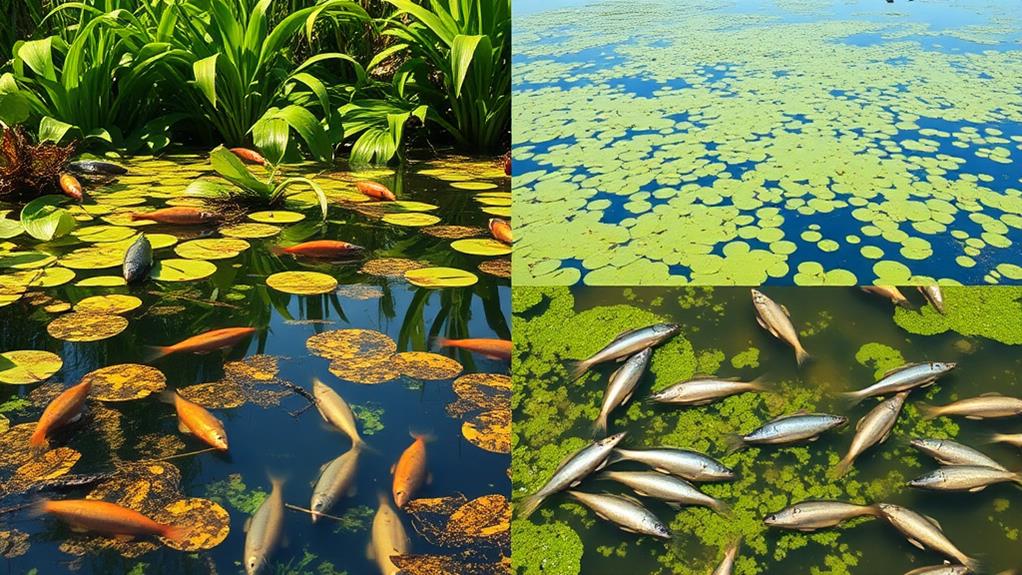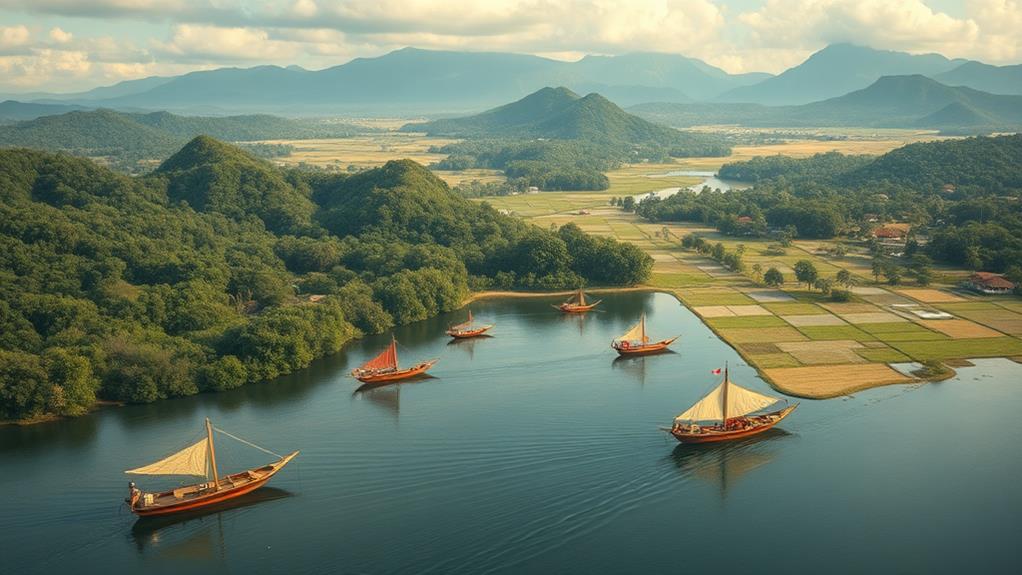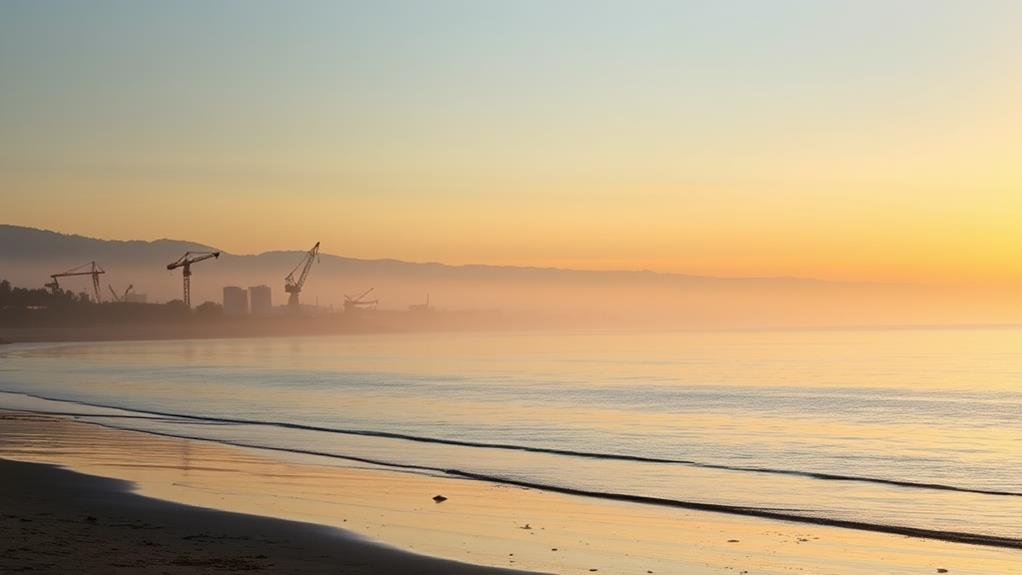Laguna de Bay: A Vital Ecosystem Under Threat
Laguna de Bay is a crucial ecosystem that supports the livelihoods of over 100,000 fisherfolk and significantly contributes to the country's fisheries production. However, this ecosystem faces severe threats from pollution, eutrophication, and habitat destruction.
The lake's surrounding population of 15 million inhabitants contributes to the degradation of the ecosystem. Human activities, such as industrial and agricultural practices, introduce pollutants and waste into the lake, disrupting its delicate balance.
For instance, the influx of nutrient-rich pollutants can lead to eutrophication, causing excessive algal growth and depleting the oxygen supply for aquatic life.
To address these issues, understanding the intricacies of Laguna de Bay's ecosystem health is crucial.
Conservation efforts and management strategies must be implemented to promote sustainable development. This requires a comprehensive approach that involves monitoring water quality, restoring habitats, and promoting responsible land use.
By taking these steps, we can work towards preserving the ecosystem's balance and ensuring a sustainable future for the communities that depend on it.
Laguna De Bay's Ecosystem Profile

Laguna de Bay's Unique Ecosystem
Laguna de Bay, the largest freshwater lake in the Philippines, supports a diverse array of flora and fauna.
Its 911-949 km² expanse comprises a delicate balance of aquatic ecosystems, providing livelihoods for over 100,000 fisherfolk.
Economic Importance
The lake contributes 17% of the national fisheries production and 10% of aquaculture production, making it a vital economic hub.
Threats to Ecosystem Health
However, the ecosystem health is threatened by severe pollution, with over 60% of the surrounding 15 million inhabitants dumping waste into the lake or its tributaries.
This leads to eutrophication and hypoxic conditions, compromising the lake's water quality.
Water Quality Concerns
The lake's water quality is compromised, with dissolved oxygen levels dropping to 2-4 mg/L, imperiling aquatic life.
Preservation and Conservation
To ensure sustainable management and conservation of Laguna de Bay, it's essential to address pollution and promote eco-friendly practices.
Physical and Chemical Dynamics
Laguna de Bay's Ecosystem: Understanding Physical and Chemical Dynamics
The physical and chemical dynamics of Laguna de Bay play a critical role in shaping the lake's overall health. Despite its shallow average depth of 2.8 meters, the lake exhibits complex interactions between its physico-chemical conditions.
Vertical and Diel Variations
Intensive observations have revealed significant vertical and diel variations in physico-chemical conditions over a 48-hour period. For instance, solar irradiance measures 800 W/m², and turbidity levels range from 16-32 FTU. Additionally, Secchi disc transparency is 25 cm, indicating limited light penetration.
Nutrient Concentrations and Wind-Driven Circulation
Diurnal fluctuations in nutrient concentrations, including nitrate, nitrite, ammonium, and phosphate, affect the lake's ecosystem health and metabolic processes. The wind-driven, density-induced two-layer current pattern influences overall hydrodynamic conditions.
Impact on Water Quality and Ecosystem Health
These dynamics have a profound impact on water quality, with high turbidity levels limiting light penetration and biological activity.
Understanding these physical and chemical dynamics is crucial for preserving Laguna de Bay's ecological integrity and promoting sustainable development.
Biological Activity and Eutrophication

Biological activity in Laguna de Bay is higher due to polluted water intrusion from Metro Manila, leading to regular occurrences of bottom hypoxic conditions with dissolved oxygen levels dropping to 2-4 mg/L.
Laguna de Bay is classified as generally hypereutrophic, primarily net heterotrophic, with a gross primary productivity to respiration ratio (GPP:R) less than or equal to 1 and a net ecosystem productivity (NEP) of zero. This indicates significant nutrient enrichment issues.
Eutrophication in Laguna de Bay is driven by four key indicators:
Nutrient pollution from fertilizers and wastewater drives eutrophication, resulting in harmful algal blooms that severely impact aquatic life and biodiversity. For example, excess nutrients from agricultural runoff and sewage can lead to an overgrowth of algae, which deplete oxygen in the water.
Algal blooms not only block sunlight, hindering phytoplankton growth essential for fish food sources, but also contribute to fish kills through the depletion of oxygen levels during decomposition processes. When algae die and decompose, they consume oxygen, leaving little for other aquatic life.
Chlorophyll-a levels and Secchi depth measurements indicate poor water quality, with proposed thresholds aimed at mitigating the effects of eutrophication and promoting ecosystem health. Chlorophyll-a levels, for instance, can indicate the presence of excessive algae growth, while Secchi depth measurements reveal the clarity of the water.
Ecosystem health is severely impacted by eutrophication, with far-reaching consequences for aquatic life, biodiversity, and water quality. As a result, eutrophication can lead to the collapse of aquatic ecosystems and the loss of biodiversity.
Temporal Dynamics and Variability
Tropical lakes exhibit unique daily cycles, which significantly influence ecological variables and often overshadow seasonal changes. For instance, 48-hour observations in Laguna de Bay reveal notable vertical and daily variations in physico-chemical conditions, such as nutrient concentrations, during both dry and wet seasons.
High turbidity levels affect light penetration, ranging from 16 to 32 FTU, which further contributes to daily fluctuations in biological activity and ecosystem health.
Frequent monitoring is crucial to understand these daily dynamics, but frequencies are often constrained by budgetary and resource limitations, highlighting the need for enhanced research efforts in tropical freshwaters.
Seasonal hydrodynamic and water quality changes drive variations in metabolic rates, underscoring the importance of understanding temporal and spatial dynamics in lake ecosystems.
Effective conservation and resource management in Laguna de Bay require a deeper understanding of these daily dynamics and their impact on ecosystem health, water quality, and nutrient concentrations.
Historical Context and Management

Managing Laguna de Bay's ecosystem requires understanding its historical context. Rapid urbanization and industrialization have led to significant environmental challenges. To address these challenges, it's essential to grasp the lake's complex history and develop effective management strategies.
The development of tropical limnology has been slower compared to temperate regions, resulting in a dominance of temperate literature in current research on tropical lakes like Laguna de Bay. This highlights the need to focus on tropical lake management.
Four historical pressures have contributed to the lake's environmental challenges:
- Rapid urbanization and industrialization have increased eutrophication and pollution, harming the lake's ecosystem.
- Deforestation and land conversion have contributed to ecosystem degradation, leading to loss of biodiversity.
- A historical lack of proactive management has allowed pollution and resource management issues to persist, exacerbating environmental problems.
- Insufficient ecological governance has hindered stakeholder engagement and conservation efforts, making it difficult to address environmental concerns.
To promote sustainable development and ecological governance, the Laguna Lake Development Authority (LLDA) was established.
Understanding the historical context of Laguna de Bay highlights the need for sustainable management practices that prioritize pollution reduction, conservation, and stakeholder engagement to protect the lake's health and biodiversity.
Ecosystem Metabolism and Carbon
Laguna de Bay's ecosystem metabolism has a significant impact on its carbon dynamics.
The complex interactions within the lake's ecosystem affect its ability to absorb or release carbon dioxide. Net ecosystem productivity (NEP) is a crucial factor in understanding aquatic carbon cycling. In Laguna de Bay, research shows that the lake exhibits net heterotrophic conditions due to high organic carbon inputs from polluted water sources. This results in a gross primary production (GPP) to respiration (R) ratio of less than or equal to 1 and an NEP of 0.
The lake's biological carbon pump (BCP) effect is enhanced, releasing CO2 into the atmosphere. This highlights the significance of aquatic metabolism in carbon dynamics. The stability of dissolved inorganic carbon (DIC) in Laguna de Bay is linked to carbonate weathering processes, suggesting the potential for significant carbon sinks in DIC-rich environments.
Photosynthesis rates are negatively impacted by reductions observed in the afternoon, correlating with lower CO2 ratios. This affects overall lake metabolism.
Interestingly, research suggests that some tropical lakes, including Laguna de Bay, may act more as carbon sinks than sources. Understanding lake metabolism is essential for sustainable conservation and management strategies that prioritize ecosystem health.
Human Impact and Environmental Pressures

Laguna de Bay's ecosystem is struggling due to human activities, which have disrupted its delicate balance by introducing pollutants and waste from surrounding urban and industrial centers.
Human impact is a significant contributor to the lake's decline. The 15 million people living around the lake dispose of waste directly into the lake or its tributaries, leading to severe pollution. Over 60% of the inhabitants engage in this harmful practice.
Nutrient pollution and eutrophication are also major environmental pressures. Fertilizers, livestock runoff, and domestic waste cause harmful algal blooms, which block sunlight and deplete oxygen levels in the water. Fertilizers and livestock runoff are the primary sources of these pollutants.
Invasive species and habitat loss are additional threats to the lake's ecosystem. Urban expansion introduces invasive species and destroys habitats, further threatening local biodiversity and fish populations. Urban expansion is the main driver of this problem.
Hypoxic conditions are a frequent occurrence in the lake, with dissolved oxygen levels dropping to as low as 2-4 mg L. This has a significant impact on aquatic life and fisheries.
The consequences of these environmental pressures are devastating for fishing communities like Cardona, which face severe livelihood challenges due to the lake's deteriorating health.
Conservation Efforts and Strategies
Conservation Efforts are Crucial for Laguna de Bay's Ecosystem
The lake's ecosystem is struggling, and conservation efforts are necessary to mitigate the damage. The CLEAR partnership, established in 2001, is a key initiative that brings together the Laguna Lake Development Authority, the Save Laguna Lake Movement, and Unilever Philippines to promote lake conservation and sustainable resource management.
Watershed Management and Sustainable Practices
The partnership has implemented various conservation strategies, including watershed management programs to protect the lake's water source and sustainable fishing practices to maintain a healthy fish population.
Additionally, reforestation efforts around Laguna de Bay are underway to restore habitats and prevent soil erosion.
Community Engagement and Education
Community engagement is a priority, with initiatives like the CLEAR Ecological Camp educating youth on environmental stewardship and lake conservation. This helps raise awareness and promote active involvement in conservation efforts.
Monitoring and Adaptive Management
Regular monitoring of water quality and ecosystem health is conducted to track the effectiveness of conservation efforts. An emphasis is placed on adaptive management strategies to address emerging environmental challenges and ensure the long-term health of the lake.
Future Conservation Goals
Looking ahead, conservation efforts aim to strengthen policies and regulations for environmental protection while fostering collaboration among local communities and stakeholders to enhance the ecological integrity of Laguna de Bay.
Sustainable Development and Management

The Laguna de Bay Basin is a vital source of fish supply for Metro Manila, with over 40% of the city's fish coming from the lake.
Sustainable development and management of the lake's resources are crucial for both environmental protection and urban food security.
The Laguna Lake Development Authority (LLDA) aims to achieve sustainable development in the Laguna de Bay Basin by 2020. This goal is based on sound ecological governance and stakeholder engagement to control industrial and household waste.
To ensure ecosystem health, several initiatives are in place:
Ecosystem accounting involves monitoring changes in lake bathymetry, sediment loading, and water quality indicators to inform natural resource management practices. This helps track the lake's health and make data-driven decisions.
Community engagement is key to promoting local ecotourism and conservation awareness. The CLEAR partnership engages communities in sustainable fishing practices and habitat restoration efforts, ensuring the lake's long-term health.
Education and awareness are essential for environmental stewardship. Initiatives like the CLEAR Ecological Camp educate youth on sustainable practices and environmental stewardship, inspiring the next generation of conservationists.
Balanced conservation is critical to striking a balance between protecting Laguna de Bay's biodiversity and meeting urban demands. This approach ensures the lake's long-term health and resilience. To achieve balanced conservation, it is important to consider the impact of human activities and pollution on the lake’s ecosystem, while also recognizing the cultural and economic significance of the area. By implementing sustainable practices and engaging local communities in conservation efforts, we can safeguard the biodiversity of Laguna de Bay while also meeting the needs of the growing population in the surrounding area. Additionally, we must also consider the impact of deforestation in the northern sierra madre on the watershed that feeds into the lake.
How can we balance conservation and development in vital marine ecosystems like Laguna De Bay and Tañon Strait?
Balancing conservation and development in vital marine ecosystems like Laguna De Bay and tañon strait protected seascape is crucial for sustainable growth. Implementing strict regulations and sustainable practices can help protect marine life while allowing for responsible economic activities. It’s essential to prioritize the preservation of the Tañon Strait Protected Seascape for future generations.
Future Directions and Research Needs
Future Directions and Research Needs
To ensure the long-term sustainability of Laguna de Bay, several critical research gaps must be addressed.
Urbanization and industrialization's impact on water quality and biodiversity must be investigated. For instance, understanding the effects of domestic waste on nutrient levels and algal blooms is crucial, as over 60% of residents contribute waste to the lake and its tributaries.
The effectiveness of management strategies in mitigating eutrophication and improving fisheries sustainability must be assessed. This is particularly important, as fisheries sustainability accounts for 17% of national fisheries production, and the Laguna Lake Development Authority's (LLDA) strategies are critical in this regard.
Community engagement and education initiatives, such as the CLEAR Ecological Camp, have a potential role in promoting sustainable practices and conservation awareness among local populations.
The long-term effects of climate change on hydrology and biodiversity in Laguna de Bay must also be investigated, as rising temperatures and altered rainfall patterns threaten the ecological integrity of this vital ecosystem.
Frequently Asked Questions
What Are the Ecosystem Services of Laguna De Bay?
Laguna de Bay provides essential ecosystem services that support biodiversity and human well-being.
The lake supports habitat conservation, which ensures a healthy fish population. This is critical for maintaining the balance of the ecosystem and supporting the livelihoods of people who depend on the lake's resources.
Water quality is critical for irrigation, making Laguna de Bay a vital source of water for agriculture and other human activities.
The lake's sediment management also prevents flooding, which protects nearby communities and infrastructure from damage.
Community engagement is essential for promoting sustainable practices in the management of Laguna de Bay.
What Is the Economic Importance of Laguna De Bay?
The Fishing Industry: Laguna de Bay is a significant contributor to the national fish production, with the lake providing a livelihood for thousands of fishermen and their families. The fishing industry generates substantial revenue for the local economy, making it an essential economic driver.
Tourism and Agriculture: The lake's natural beauty and rich biodiversity attract tourists, supporting the local tourism industry.
Moreover, the surrounding areas are suitable for agriculture, with crops like rice, sugarcane, and coconut being major contributors to the regional economy.
Water Supply and Transportation: Laguna de Bay serves as a reliable source of water for industries, agriculture, and communities in the surrounding areas.
Its strategic location also makes it a vital transportation hub, facilitating regional commerce and trade.
Cultural Significance: The lake holds cultural and historical significance, attracting visitors interested in exploring its rich heritage.
This cultural importance contributes to the local economy through tourism-related activities.
Water Quality and Sustainability: Maintaining the lake's water quality is crucial for sustainable development, as high treatment costs for water can be detrimental to the economy.
Preserving the lake's ecosystem is essential for ensuring the long-term viability of these economic benefits.
What Are the Environmental Issues in Laguna De Bay?
Laguna de Bay faces multiple environmental issues.
The lake's water quality is poor due to pollution from various sources. Fertilizers and wastewater are among the main pollutants, contaminating the water and causing harmful algal blooms. These blooms deplete the oxygen in the water, making it difficult for aquatic life to survive.
Invasive species also threaten the ecosystem. For instance, the janitor fish has been known to consume native species, disrupting the food chain.
Habitat loss and destructive fishing practices further exacerbate the problem. The lake's habitats, such as the wetlands and mangroves, are being destroyed, leaving many species without a place to live. Destructive fishing practices, like overfishing and dynamite fishing, deplete the lake's fish population and damage the ecosystem.
Climate change is another significant factor affecting the lake. Rising temperatures and changing weather patterns disrupt the delicate balance of the ecosystem, making it challenging for species to adapt and survive.
What Is the Purpose of the Laguna Lake Development Authority?
The Laguna Lake Development Authority's primary goal is to manage and promote sustainable development in the Laguna Lake Basin.
The authority oversees ecological governance by implementing policies to control waste and monitoring water withdrawal to ensure sustainability. For instance, it regulates the amount of wastewater discharged into the lake and monitors the water level to prevent over-extraction.
The LLDA also focuses on stakeholder engagement and education initiatives to raise awareness about conservation strategies.
This involves educating local communities, industries, and other stakeholders about the importance of conservation and the role they can play in protecting the lake's ecosystem.